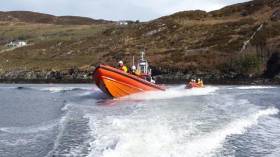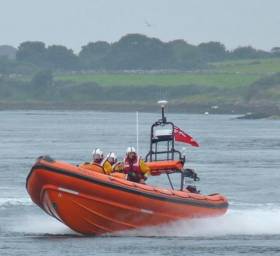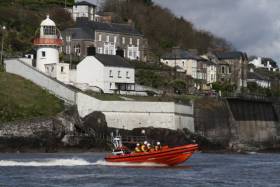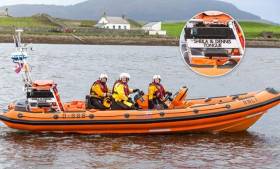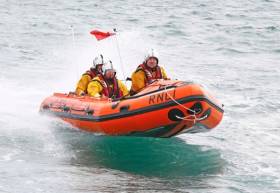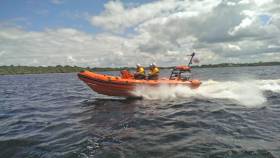Displaying items by tag: Lifeboats
Fethard Lifeboat Launches In Search For Missing Person
#RNLI - Fethard RNLI launched their inshore lifeboat yesterday afternoon (Wednesday 20 April) following concerns that a person may have been missing on the Hook Peninsula in Co Wexford.
The alarm was raised when a man did not return from a walk at Hook Head when expected.
The volunteer lifeboat crew responded quickly to a launch request by the Irish Coast Guard following the report at 4.30pm.
The D-class lifeboat Tradewinds, helmed by John Colfer together with three volunteer lifeboat crew, launched at Slade Harbour within minutes following the pager alert, assisted by five shore crew who began a shoreline search.
At 5.15pm the search was stood down with the notification that the man was found safe and well.
Speaking following the callout, Fethard RNLI deputy launching authority Hugh Burke said: "We would like to commend the member of the public who raised the alarm today when they were concerned. We would always rather launch to a false alarm with good intent than not launch at all.
"Our volunteers responded quickly this afternoon to aid in the search at sea and on the shore but we were stood down quickly on hearing the good news that the man was not missing but overdue and had been located safe and well."
Fethard RNLI is always looking for new volunteers from all walks of life to join their lifesaving team.
If you are aged 17 or over and would like to find out more please contact the lifeboat station or make a visit during its May Bank holiday open weekend.
East Meets West As Skerries Lifeboat Crew Visits Clifden
#RNLI - Skerries RNLI's volunteer crew headed to the West of Ireland this month as they paid a visit to their colleagues in Clifden RNLI.
Once a year the volunteers in Skerries undertake a team-building and fact-finding trip to other rescue services and lifeboat stations.
Despite being located on opposite sides of the country, Skerries RNLI and Clifden RNLI had previously exercised together, along with Clogherhead RNLI, off the East Coast back in 2014.
On that occasion the Clifden crew were being trained on the Mersey-class all-weather lifeboat that the station took on for a 12-month trial.
Last Saturday (16 April), Clifden RNLI launched all three of their lifeboats – a Mersey-class, an Atlantic 85 inshore lifeboat and a D-class inshore lifeboat – to take the volunteers from Skerries afloat and give them a taste of the challenges they faced on the West Coast and at their own station in particular.
Skerries RNLI would like to thank volunteers Philip Ferguson and Laura Boylan for organising the trip; Irish Rail, who very generously subsidised the travel costs; and most importantly all, the volunteers at Clifden RNLI for giving up their time and extending a warm welcome.
Speaking about the exercise, Skerries RNLI volunteer lifeboat press officer Gerry Canning said: "It’s always a great learning experience for our volunteers to see the challenges that face other crews around the coast, and how they deal with them.
"The guys from Clifden RNLI were fantastic and really pulled out all the stops to make sure we went afloat and got a good insight into why they require each of their boats."
#RNLI - Portaferry RNLI's volunteer lifeboat crew were called out yesterday afternoon (Sunday 17 April) to assist a 36ft angling vessel which had run into difficulty north of the South Rock Light Buoy near Portaferry, Co Down.
The alarm was raised just before 12.25pm and the lifeboat was dispatched to the scene, some 10 miles east of the lifeboat station.
The angling boat, with three people on board, had developed engine problems in what were described as calm conditions with a Force 3 wind and a slight sea swell.
When on scene, the lifeboat crew checked everyone was okay before taking the vessel under tow to Portavogie, arriving there at 2pm. The lifeboat was back on station at 2.30pm.
Commenting on the callout, Portaferry RNLI lifeboat operations manager Brian Bailie said: "This was a fairly routine callout for the lifeboat crew and we were glad to be able to offer assistance.
"However as we approach the busy season and more people are taking to the water for leisure we would advise the public to make sure they check all their equipment is in proper working order."
The RNLI offers sea safety advice online at RNLI.org/RespectTheWater
New Atlantic 85 Class Lifeboat Arrives At Youghal RNLI
#RNLI - A new Atlantic 85 class lifeboat has gone on service at Youghal RNLI.
The lifeboat, which arrived at the east Cork lifeboat station on Monday evening (11 April), replaces Patricia Jennings, which has been used to save lives at sea in East Cork since 2002.
Yesterday afternoon (Tuesday 12 April) the volunteer lifeboat crew began a week of familiarisation training with their first exercise on the Gordon and Phil.
The new lifeboat has been funded through a legacy from the late Gwenda Bull, a native of Brighton in East Sussex, England, who was a supporter of the charity’s volunteers in saving lives at sea.
The lifeboat Gordon and Phil is named after Gwenda’s parents in their memory. Prior to her death at the age of 82 in 2013, Gwenda who lived near Shoreham lifeboat station which she visited regularly, said her family had always admired the wonderful work of the RNLI.
The Gordon and Phil will be officially named at a special naming ceremony and service of dedication at Youghal lifeboat station later this year.
In her 14 years in Youghal, Patricia Jennings launched 175 times, with its volunteer lifeboat crew rescuing 233 people, nine of whom were lives saved.
The new lifeboat has some advancement on its predecessor. The Atlantic 85 design allows room for four crew members and more kit than the Atlantic 75 lifeboat, which only had room for three crew members.
The lifeboat is powered by two 115-HP engines and has a stronger hull and greater top speed of 35 knots. The added radar allows the crew to operate more effectively in poor visibility and there is also VHF direction-finding equipment.
The vessel has a manually operated self-righting mechanism which combined with inversion-proofed engines keeps the lifeboat operational even after capsize. The lifeboat can also be beached in an emergency without causing damage to its engines or steering gear.
The Atlantic 85, which was introduced to the RNLI fleet in 2005 also carries a full suite of communication and electronic navigation aids, as well as a searchlight, night-vision equipment and flares for night-time operations.
Speaking following the arrival of the new lifeboat, Youghal RNLI lifeboat operations manager Fergus Hopkins said: "We are extremely grateful to Gwenda Bull for her generous legacy donation which has funded our new lifeboat.
"As we welcome a new lifeboat, there is also a sense of nostalgia among us today too as we bid a fond farewell to Patricia Jennings who provided us with 12 great years of service. Patricia Jennings time here in Youghal saved lives and brought many more people safely to shore and we hope her donor family will be just as proud as we are, of her many achievements.
"We are looking forward to being the custodians of this new lifeboat which will allow our volunteers to go on to rescue and save many more lives in the years to come."
Larne Lifeboat Crew Trains With Dublin Coastguard Helicopter
#RNLI - The RNLI volunteer lifeboat crew from Larne carried out a training exercise with the Dublin-based Irish Coast Guard helicopter Rescue 116 off Ballygally Head yesterday (Sunday 10 April).
The Sikorsky S-92 initially visited Larne on 20 March last when they landed on Curran Point. The visit consisted of a briefing to Larne RNLI crew and included an orientation of the helicopter. The Larne Coastguard team was also present on the day, securing a safe landing zone for the helicopter.
Larne RNLI launched both their relief all-weather lifeboat Windsor Runner and inshore lifeboat Terry yesterday for the exercise to simulate recovery of a casualty to a helicopter in an emergency situation.
The lifeboats practiced manoeuvres at speed with Rescue 116. A crew member was winched into the helicopter and a casualty stretcher was transferred from the helicopter to the lifeboat. The helicopter winchman also landed onto the inshore lifeboat.
The RNLI regularly carries out exercises with other rescue agencies. It is this training that ensures the crew are able to work effectively with other agencies in an emergency situation, including medical evacuation of a casualty to a helicopter.
Larne RNLI coxswain Frank Healy said: "This was a very valuable exercise with the Irish Coast Guard. It's fantastic to step up the volume and breadth of our training coming into what is traditionally a busy summer period for call outs. Our thanks to the Irish Coast Guard for making this exercise possible."
#RNLI - Bangor RNLI’s volunteer lifeboat crew launched at 7pm on Tuesday evening (5 April) to help in the rescue of a yacht whose engine had failed on passage from Stranraer to Bangor on Belfast Lough.
Bangor RNLI’s lifeboat operations manager Kevin Byers was first made aware of the situation by Belfast Coastguard at 5pm when the yacht was 15 miles northeast of Bangor, and knew that it had been taken in tow by the inbound fishing trawler Aurelia.
As the Aurelia was too large to bring the yacht all the way in to Bangor Marina, the Bangor lifeboat was launched just after 7pm to complete the rescue.
The yacht, with two adults and two children on board, was under power as there was little wind and the sea was calm. Unfortunately, the engine stopped and they were being carried by the tide.
Bangor RNLI's volunteer helm Gareth Whan said later: “This was a great example of good teamwork. Luckily, the Aurelia was able to bring the yacht most of the way, and we were able to complete the job, bringing it safely into Bangor Marina.
“Unfortunately, regardless of your preparation, engines can break down, and the lifeboat crew were all delighted to bring this group of people safely ashore."
#RNLI - The new Sligo Bay RNLI Atlantic 85 lifeboat is to be officially named Sheila & Dennis Tongue during a ceremony at the lifeboat station at Rosses Point in Sligo next Saturday 16 April 2016 at 3pm.
The lifeboat will be passed into the care of the RNLI and officially named during a short ceremony and service of dedication by brothers Raymond and Philip Tongue, who are nephews of the couple and will travel to Ireland with their families for the special event.
Mr and Mrs Dennis Tongue left a generous legacy to the RNLI in recognition of the vital life-saving work of the charity and as a thank-you for the happy days they spent living on the coast at Exmouth.
The couple were born in Birmingham in the 1920s and on Dennis’s retirement they moved to Devon where they lived until their eighties, overlooking the coast.
The couple did not have any children and it was during their retirement that they came to know and admire the work of the RNLI and recognise its place in the life of the communities it served.
The new lifeboat that arrived in Sligo last November, as previously reported on Afloat.ie, replaces Elsinore, which during its 13 years on service launched 189 times and rescued 155 people.
Sligo Bay RNLI lifeboat operations manager Willie Murphy, who will be accepting the lifeboat into the care of the station from the Tongue family on behalf of the volunteers, said: "I would like to express our sincere gratitude to the late Mr and Mrs Tongue for their generous and life-saving gift.
"This lifeboat is the vessel that will carry our volunteer lifeboat crew out to sea to save lives and rescue people in difficulty and it will provide our volunteer lifeboat crew the opportunity to train and develop their skills to carry out that work.
"We look forward to welcoming the family of Sheila and Dennis to this beautiful part of the world and we hope this is the beginning of a wonderful friendship with them."
The Atlantic 85 lifeboat was built at a cost of €276,000 and was introduced into the RNLI fleet in 2005. It operates mostly in shallow waters close to the shore or cliffs, among rocks and caves. It is operational in conditions up to a Force 7 and the design accommodates four crew and multiple casualties.
The lifeboat has a top speed of 35 knots and has a manually operated righting mechanism with inversion proofed engines, meaning it can be righted after capsize and kept operational.
The boat is also capable of being beached in an emergency without sustaining damage to the engines. It carries a full suite of communication and electronic navigation aids.
Sligo Bay RNLI crew and management will put their new lifeboat on display to the general public on their station open day on Sunday 19 June.
#RNLI - Four local towns went head-to-head at a recent quiz night in a bid to raise funds for Fethard RNLI’s new inshore lifeboat appeal.
Some 62 tables took on the challenge in four venues in Fethard on-Sea, Duncannon, Campile and New Ross last Friday (1 April) to determine which village or town would take the ‘Don’t be a fool on April Fool’s Day’ crown.
The honours went to New Ross on the night, with the winning team represented by Luke Grennan, Dan Meaney, Pat Kenny and Denis North.
Speaking following the event, Fethard RNLI fundraising chair Oonagh Hearne said: "Around 248 people enjoyed a great family evening with 62 tables participating and helping us to raise €3,000 towards our new inshore lifeboat appeal.
"Thank you to everyone who supported the event including The Brandon House Hotel, Neville’s Bar, Dunphy’s Bar and the Strand Tavern. Thanks to everyone who took part, the companies who donated prizes and all who helped organise the event. The community spirit was incredible."
Fethard RNLI hopes to raise €65,000 in their 18-month fundraising appeal which will go towards the cost of a new D class lifeboat due to arrive at the station late next year.
Two Callouts In 24 Hours For Lough Ree Lifeboat
#RNLI - The volunteer lifeboat crew with Lough Ree RNLI were called out twice in 24 hours to assist grounded vessels in the Wood Shoal area.
Thankfully there were no injuries any of those on board across both vessels, but the RNLI has advised marine users in the area to use caution and heed advice around submerged rocks.
The first callout came after midday on Tuesday (29 March) to reports of a cruiser with 10 people onboard grounded at Mouse Ear Rock.
When on scene, a lifeboat crew member boarded the vessel and assessed it for damage. There was a strong vibration from the engine and it was suspected that there may be damage to the propeller.
The lifeboat crew took the vessel under tow to Portrunney were it could be checked over for damage. The lifeboat was back on service shortly after 2pm with everyone safely ashore.
The second callout came the next day (Wednesday 30 March) at 3.35pm and was again to a grounded vessel, this time at Iskeraulin Shoal, south of Quaker. There were six people onboard with no reports of injuries.
On arriving on scene at 4.06pm, the lifeboat crew again assessed if there was any damage to the cruiser.
When it was confirmed that everything was working they helped the vessel free of the rocks and monitored its progress by travelling alongside it for a time. Once satisfied there was no further difficultym they departed the scene and returned to the station.
Commenting on the callouts, Lough Ree RNLI lifeboat operations manager Damien Delaney said: "Our volunteer lifeboat crew had a busy 24 hours. We would urge everyone using Lough Ree to ensure they are familiar with the area and to take heed of any warnings for rocks.
"Grounded vessels are not unusual but with any callout there are a number of factors that should be considered, such as weather and the right equipment. Make sure you have a suitable means of calling for help and that you have the proper clothing and a lifejacket. You never know when you will need to call for help."
Lough Ree was among the busiest of Ireland's lifeboat stations in 2015, recording the highest number of people assisted, as previously reported on Afloat.ie.
Bangor Lifeboat Aids Fishermen After Engine Failure
#RNLI - Bangor RNLI’s volunteer lifeboat crew were requested by Belfast Coastguard to help two fishermen on a 17ft motorboat with engine failure.
Although conditions were calm and the crew were in no immediate danger, the westerly wind was extremely cold and blowing the fishing boat offshore.
The call to lifeboat operations manager Kevin Byers came in at 5.06pm yesterday evening (29 March) and the lifeboat launched at 5.15pm.
The lifeboat made its way to the reported position to the south of the Gobbins outside Belfast Lough, only to find the boat wasn’t there, and they were only able to locate it by radioing the boat for a position update.
On arrival, the volunteer lifeboat crew made sure the boat and crew were sound, and towed the boat to Carrickfergus Harbour, where they were thanked by an extremely grateful skipper.
Helming Tabby Cat, the temporary replacement for Bangor's regular lifeboat Jessie Hillyard, Bangor RNLI crewmember Gareth Whan said: “An incident like this emphasises the importance of good engine maintenance, particularly as many boats have been unused over the winter months.
“It also demonstrates the importance of warm clothing, as the crew of the rescued boat were extremely cold by the time we reached them – it is always much cooler on the water than it is on dry land.”



























